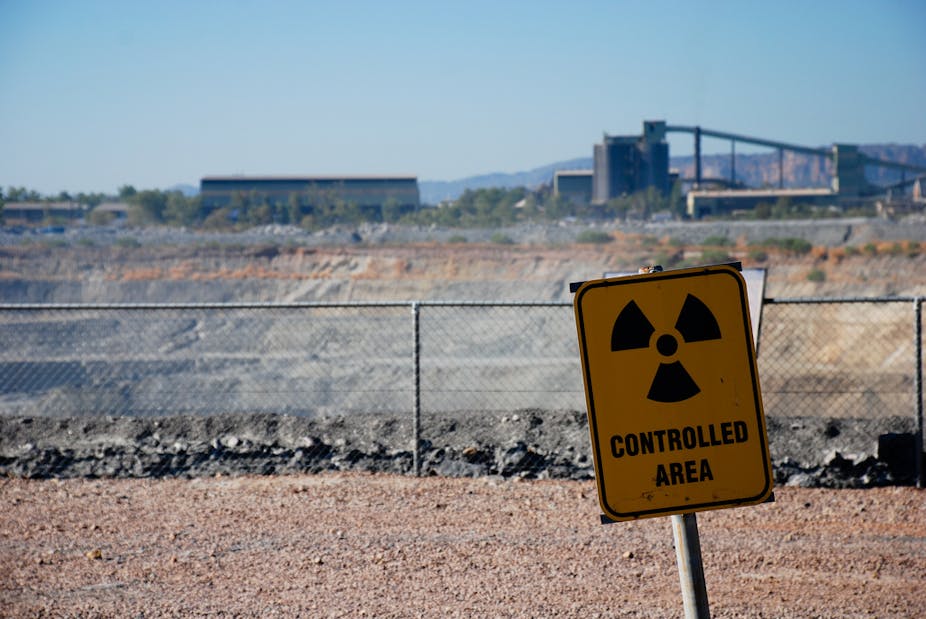Can you imagine Prince William, on his visit to Australia, being gifted a specimen of uranium? That’s what happened to his grandfather Prince Philip on a Royal Tour during the first great age of Australian uranium mining, the 1950s, when the young Queen Elizabeth’s consort was presented with a lump of the stuff resting in a casket.
Things were so much simpler in the 1950s. Australia’s reserves of the mineral were a source of pride, clinching the emerging nation’s status as a place of importance in the post-war world. At a time when the British were conducting a programme of nuclear testing on remote Australian soil, with nary a thought for its Aboriginal inhabitants, atomic technology meant progress and modernity.
Back then, they called uranium ‘the modern Midas metal’. Not anymore. Now there is no more controversial mineral in the earth’s crust (where it is nearly as common as tin). In Australia, which contains up to 40% globally of its recoverable reserves, uranium is feared and reviled.
And mined: encouraged by the Labor Government, uranium mining has been enjoying a renaissance, after decades of relative stasis. New mines have opened up, and new players as well as usual suspects like BHP Billiton have been eyeing potential sites in South Australia, in Western Australia and that old cornucopia of uranium, the Northern Territory.
Then came Fukushima. The near-calamity in north-eastern Japan in the wake of the dreadful earthquake and tsunami has sent uranium shares plummeting, put the wind up would-be venturers and investors, and re-entrenched Australian historical unwillingness - since the no-nuke campaigns of the 1970s - to countenance a nuclear industry of its own.
Before the crisis at the Fukushima plant, polls were suggesting that Australians may have been warming to the prospect of nuclear power. Early polling since the Japanese tragedy shows that support has slumped to around 35%.
Australians tend to be protective of their mining industry, even objecting in large numbers to the super-profits tax the Government sought to impose on the big miners in 2009.
While that indulgence has not generally been afforded uranium, most people have turned a blind eye to the palpable boom in the uranium business. After all, the mines are a long way away from major population centres, and fuelling the industrial growth of a client county such as China guarantees our prosperity.
The Fukushima crisis has revived primal post-Hiroshima Australian fears of atomic fission. Nuclear energy debates in this country swing between simplistic and diametrically opposed propositions: it will either save us from climate change, or it spells doom for us all.
Until Fukushima, advocates on the ‘pro’ side looked like prevailing. Hadn’t the Energy Minister, Martin Ferguson, gone on record to call nuclear power ‘proven, clean-energy technology’? And hadn’t the government’s fall guy for dispensing with the ‘Three Mines’ policy been Peter Garrett, the once-vociferous anti-nuclear campaigner now unfairly cast as a compliant Environment Minister, seemingly acceding to every new mining proposal?
During those tense days at the Fukushima complex, as a small band of Japanese workers struggled to prevent a meltdown, veteran nuclear doomsayers like Richard Broinowski (brother of the irrepressible Helen Caldicott) bobbed up everywhere, predicting apocalypse.
Press reportage was atrociously sensationalistic: Nevil Shute’s end-of-the-world novel On the Beach seemed to have been transposed to the battered shores of eastern Honshu.
The Greens said ‘I told you so’, and both major parties backtracked from the nuclear option at a hundred miles an hour. You won’t hear Martin Ferguson talking up nuclear power now; and Tony Abbott has temporarily erased it from the Liberal agenda.
Yet, while the emergency is far from over, the apocalypse predicted at Fukushima has not come to pass. The Australian uranium market will recover: certainly, there is no evidence that the Government will seek to curtail it.
All of which makes its intransigent opposition to nuclear power the more curious. If nuclear energy is so dangerous, why plunder our landscape and then flog the fundamental nuclear fuel, uranium, to an expanding and highly volatile international market?
The Tokyo Electric Power company, the operator of the Fukushima complex, has been a big buyer of Australian uranium, so it is possible it was our material that provided the radioactive by-products emanating from its crippled reactors.
The website of the government mega-department responsible for uranium, Martin Ferguson’s ‘Resources, Energy and Tourism’, illustrates the hypocrisy of the Australian position on the mining and export of the mineral. ‘Australia’s uranium,’ the website boasts, ‘plays an important part in the global effort to address climate change’.
The logical question to ask, therefore, is: ‘Why then not consider the prospect of nuclear power in Australia?’ Heavily dependent on its reserves of fossil fuels, Australia was recently accorded the dubious honour of being ranked one of the world’s three largest carbon emitters, along with the United States and the United Arab Emirates.
The next two sentences on the Energy Department website are revealing: ‘In 2007, Australia’s uranium exports contributed $881 million to the Australian economy. If proposed expansions to existing mines proceed, Australia could become the world’s largest producer and exporter of uranium.’
Advising the industry to hold its nerve, the South Australian Mines Minister Tom Koutsantonis let the cat of the bag earlier this week, at the annual uranium conference put on by the Perth-based media company not insignificantly called ‘Paydirt’. Far from closing down the industry, Koutsantonis said, Australia should enrich uranium on-shore instead of digging it up and sending it elsewhere. Koutsantonis clearly considers himself a comedian. We need to get ‘the maximum bang for our buck,’ he said, a possibly insensitive image to apply to nuclear energy.
Mercenary nationalism is the real driver of the Australian uranium industry, despite the Government’s avowed commitment to nuclear non-proliferation and the conditions it places on foreign sales of the mineral. In the wash-up of the Fukushima incident, that is unlikely to change.

